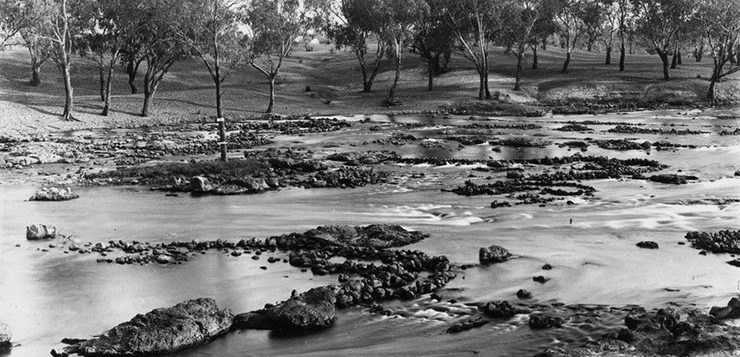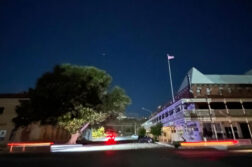We love our history in Australia. Just so long as it’s white. Chris Graham explains.
Just over a week ago, shortly after I set off on the ‘New Matilda Fantastical Historical Political Outback Tour – Aboriginal Edition’ (#NMFHPOTAE), news broke that the grave of Matthew Flinders had been discovered underneath a railway station in London. Flinders, of course, was regarded as one of Australia’s great early ‘explorers’ and the first European to circumnavigate the continent.
The story broke the day before Australia Day, when we celebrate the arrival of the British and the date marking the beginning of the brutalisation of our First Peoples. So you can imagine the orgy of self-congratulatory commentary that followed, as though we had anything at all to do with the discovery of Flinders’ grave, let alone his achievements.
One person who actually did have a lot to do with the latter, however, was an Aboriginal man named Bungaree. You possibly haven’t heard of him.
Bungaree, from the Kuringgai people north of Sydney, accompanied Flinders’ on his voyage and provided a vital service as a ‘diplomat’ of sorts, as the crew encountered other Aboriginal nations around the continent.
Remarkably, however, to this day there remains very little recognition of Bungaree, and not a single statue or plaque anywhere on the continent acknowledging his contribution. On the upside, there is a statue in England honouring Flinder’s cat, Trim, who also went along for the trip.
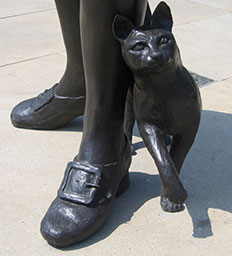
While Flinders’ grave was discovered beneath the London underground, Bungaree is believed to be buried in an unmarked grave somewhere in Sydney’s affluent eastern suburbs.
This official indifference was a timely reminder for me, because I was soon to pass through the remote NSW town of Brewarrina, a predominantly Aboriginal community in the far north west of the state.
‘Bre’, as the locals call it, has a population of around 1,000. It also happens to be home to the Brewarrina Fish Traps – known as Baiame’s Ngunnhu [pronounced By-ah-mee’s noon-oo]by the Ngemba people – which is possibly the oldest known human-made structure on earth.
Dwell on that for a second… the oldest known human-made structure on earth, dating back at least 40,000 years. That pre-dates Stonehenge, an iconic British structure, by at least 37,000 years. Dwell on that for a second too. Bre’s fish traps are more than 10 times older than Stonehenge.
Which begs the question, how does Britain celebrate an iconic ancient structure, compared to Australia? Before we answer that, it’s worth knowing exactly what the fish traps are, and how they have withstood the march of time.
Ancient technology
The Bre Fish Traps are about half a kilometre in length, and situated on a large natural rock bar on the Barwon River, right at the bend where the township of Brewarrina now sits. Large and small rocks were used to divert water (and fish) into a series of pools. Once fish were trapped, they were simply collected by hand.
The earliest known reference to the traps by a European was by William Colburn Mayne in 1848, the then Commissioner of Crown Lands. He was clearly very impressed by what he saw.
“In a broad but shallow part of the head of the River where there are numerous rocks, the Aborigines have formed several enclosures or Pens, if I may use the word, into which the fish are carried, or as it were decoyed by the current, are there retained,” Mayne wrote.
“To form these must have been a work of no trifling labour, and no slight degree of ingenuity and skill must have been exercised in their construction, as I was informed by men who have passed several years in the vicinity, that not even the heaviest floods displace the stones forming these enclosures.”
Despite Aboriginal people being banished from Brewarrina, and shuffled multiple times between missions in western and far western NSW, the custodians of Baiame’s Ngunnhu stubbornly continued to tend to their fish traps, and preserve them for future generations.
This continued into the 1970s, when the NSW Government decided to dam the Barwon with a weir, to provide water for irrigation for the few dozen farmers in the region. They built it right at the head of the fish traps, creating a pool upstream that sometimes stretches, in wetter times, for over 100 kilometres.
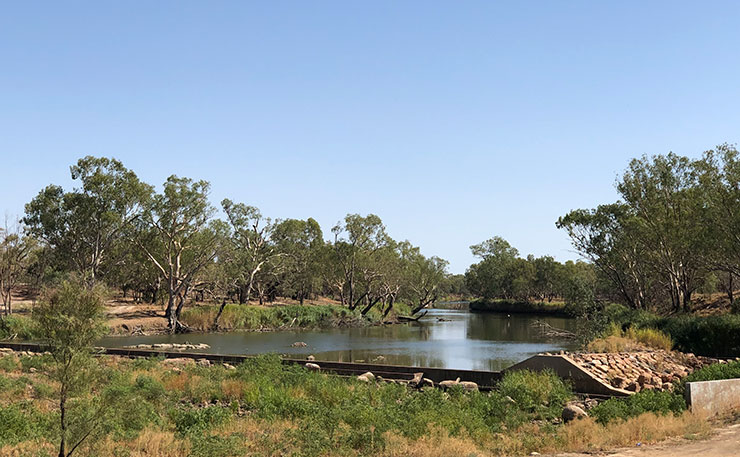
The fish traps, while obviously seriously weakened by a reduction in flow, still managed to survive courtesy of local Aboriginal people continuing to tend to them, as they had done for tens of thousands of years.
In 1988, the bi-centenary year, the federal government agreed to fund a reinvigoration of the site, including the construction of a cultural museum on the cliffs overlooking the traps. Fast forward to 2005, and the Australian Government finally decided to properly acknowledge the importance of the fish traps, by affording Baiame’s Ngunnhu status on the National Heritage register. The reasoning for the listing makes for interesting reading.
“The Aboriginal fishery at Brewarrina (Ngunnhu) is rare in being a dry-stone fish trap located on a large river system and the largest trap recorded. The Ngunnhu features a very complex design that exploits an unusual location.
Aboriginal people used the unusual combination of a large rock bar, seasonal river flows and suitable local rocks to develop the Ngunnhu. It is nearly half a kilometre long and consists of a series of dry-stone weirs and ponds arranged in the form of a net across the Barwon River. The size, design and complexity of the Ngunnhu is exceptionally rare in Australia.
The stone-walled pens are designed to withstand the high water flows of the Barwon River. They are tear-drop shaped with the convex wall facing upstream. Some of the pen walls are higher than others enabling their use during both low and high water flows. This is combined with pond gates set at different locations enabling fish to be caught as they migrated both upstream and downstream.
The structure of the Ngunnhu demonstrates the development of a very efficient method for catching fish involving a thorough understanding of dry-stone wall construction techniques, river hydrology and fish ecology.”
Which puts somewhat of a fly in the ointment of two pre-dominant Australian theories about Aboriginal people – firstly that they were a backward, Stone Age people with primitive knowledge and technology, and secondly that they were nomadic (hence they were incapable of owning land… hence why we took it all without asking).
Obviously, you don’t build and maintain (for 40,000 years) a massive structure capable of sustaining a significant food supply if you’re just passing through. Indeed, in the words of the National Heritage register:
“While the Ngemba people are the custodians of the Ngunnhu, it was Baiame’s wish that other tribes in the region, including the Morowari, Paarkinji, Weilwan, Barabinja, Ualarai and Kamilaroi should use it in an organised way. He allocated particular traps to each family group and made them responsible under Aboriginal law for their use and maintenance.
“Neighbouring tribes were invited to the Ngunnhu to join in great corroborees, initiation ceremonies, and meetings for trade and barter. The Ngunnhu were, and still are, a significant meeting place to those Aboriginal people with connections to the area and continue to be used.”
That’s all pretty effusive praise, but what’s also interesting about the National Heritage List is what else was included that same year, and the somewhat ironic date on which it all occurred.
On May 26, 2005 Minister for the Environment and Heritage, Ian Campbell officially added Baiame’s Ngunnhu to the register. May 26, of course, is National Sorry Day, but in 2005 it was renamed ‘National Day of Healing’.
Campbell also saw fit to include the ‘Port Arthur Historic Site’. What’s notable is the effort that went into researching both sites.
Baiame’s Ngunnhu explanatory notes ran to a page and a half, and not once was it acknowledged that the traps are believed to be the oldest known human-made structure on earth.
Port Arthur, by contrast, was an epic 8-page flowing prose on the extraordinary nature of the old penal settlement.
“Port Arthur is the best-known symbol of Australia’s convict past, a highly revered icon that symbolically represents Tasmania’s place in Australian history,” the listing records.
“The Arcadian qualities of the Port Arthur landscape are valued by most visitors to the place and by generations of Tasmanians. For Australians broadly, particularly those of Anglo-Celtic background, Port Arthur is a place to reconnect with their colonial roots, real or imagined, and reflect on the meanings of the past.”
Well, maybe not all the past. Just the last 150 years or so of it.
As it would transpire, so enamoured by the Port Arthur Historic Site was the Australian Government that it went on to recommend it for World Heritage Listing under the United Nations Educational, Scientific and Cultural Organization (UNESCO) in 2010.
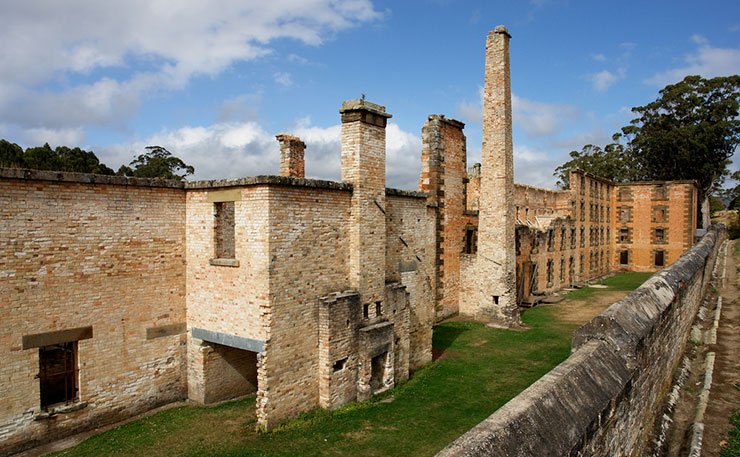
Officially there are 19 Australian sites on the UNESCO World Heritage List. There’s actually more physical locations, but some of the listings include multiple properties, such as ‘Australian Convict Sites’ which includes 11 different locations.
The Sydney Opera House is a UNSECO world heritage listed site. So too is the Royal Exhibition Building and Carlton Gardens in Melbourne, considered “one of the great enduring monuments to the International Exhibition movement, which began in the mid-19th century”.
No such luck for Baiame’s Ngunnhu though, a human-made structure which showed decidedly more ingenuity than Port Arthur, was about 40,000 years older, and had value to all of humankind, not just those with ‘real or imagined’ links to convicts from a few hundred years ago.
As for other Aboriginal sites of significance, Uluru and Kakadu were added in the 1980s, but not for their cultural importance. They were included on the World Heritage List for their natural heritage values, although both listings were eventually updated to include the remarkable Aboriginal cultural heritage that dominates both landscapes.
In the history of the UNESCO World Heritage Listings, there has only ever been one place proposed by the Australian Government exclusively for its Aboriginal cultural heritage, and it hasn’t even made the list yet. In 2017, the Turnbull Government submitted the ‘Budj Bim Cultural Landscape’ to the World Heritage List. It’s currently recorded on the ‘Sites on the Tentative List’, which is a forerunner to being afforded full world heritage listing status.
According to UNESCO: “The Budj Bim Cultural Landscape, located in South West Victoria, includes evidence of one of the world’s largest and oldest aquaculture systems, dating to about 6,600 years ago. At the Budj Bim Cultural Landscape, [the Gunditjmara people]used the abundant local volcanic rock to construct fish traps, weirs and ponds to manage water flows from nearby Lake Condah to exploit short finned eels and other fish as a food source.”
Budj Bim Cultural Landscape is undeniably a remarkable place, and more than worthy of World Heritage Listing. But it’s also believed to be significantly younger than Baiame’s Ngunnhu. Which begs a couple of final questions, and this is where things get a little awkward.
How is it that an Australian Government can see the World Heritage value in buildings that were completed as recently as 1973 (in the case of the Opera House), but not see the value in what is possibly the oldest known human-made structure on earth? And how can the government acknowledge the extraordinary Budj Bim Cultural Landscape, while ignoring Baiame’s Ngunnhu?
I have a few personal theories, and indifference/racism is only one of them. I suspect the lack of interest by the Australian Government is more related to what we’ve already done to the Bre Fish Traps, and the surrounding landscape.
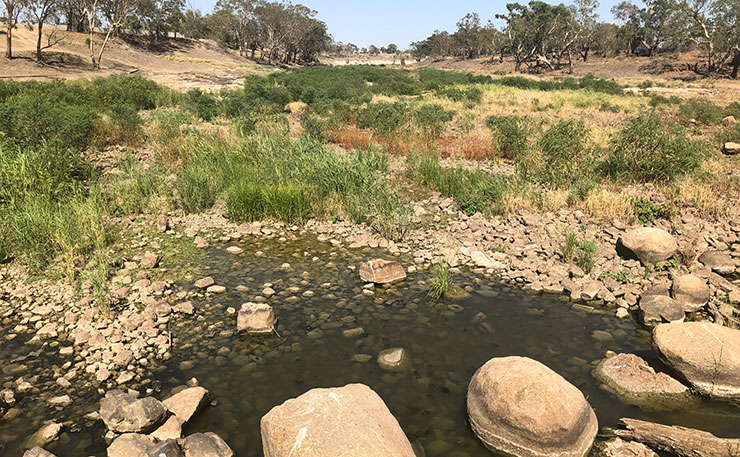
Of course, once you get a site listed on the World Heritage Register, UNESCO expects you to protect and maintain it. When I visited the Bre Fish Traps last week, you couldn’t actually see them. They’re completely overgrown by bulrush, a consequence of there being no water flow through the traps courtesy of the weir built almost half a century ago to advantage a handful of farmers upstream.
As last week’s South Australian Royal Commission noted, we’ve already seriously damaged large parts of the Murray-Darling basin, and as of today, we continue to grossly mismanage, it, often for the exclusive benefit of farmers and corporations over environmental and cultural reasons.
Ironically, my trip through northern and western NSW – the ‘New Matilda Fantastical Historical Political Outback Tour – Aboriginal Edition’ is specifically to investigate the state of the Murray-Darling basin, for a film that’s due to be completed in 2020.
The Barwon River, of course, is a crucial and substantial part of the basin. In fact, from what I can see, the Barwon IS the Darling – they’re essentially the same river.
While I’ve been on the trip, there was another massive fish kill in the lower reaches of the Barka (Darling). It’s the third in a month, with around 2 million fish killed in total.
I’m not entirely sure how an already fragile river system can recover from such a monumental and entirely human-made environmental disaster (download the Royal Commission report here). But I am entirely sure that the Bre Fish Traps can recover. With the ingenuity and perseverance of their traditional custodians, they’ve survived 40,000 years on the harshest continent on earth.
What it will require though is some genuine political will, along with an honest accounting of our past and a sensible plan for the future.
Another story for another day….
I’ll bring you a fresh yarn from the ‘New Matilda Fantastical Historical Political Outback Tour – Aboriginal Edition’ in the next few days.
Don’t miss the news – Click here to get our free email digest direct to your inbox.
Donate To New Matilda
New Matilda is a small, independent media outlet. We survive through reader contributions, and never losing a lawsuit. If you got something from this article, giving something back helps us to continue speaking truth to power. Every little bit counts.

